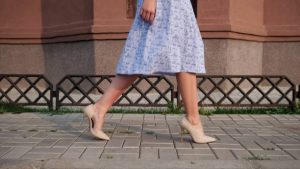The advantages of low heels include reduced risk of falling and sprains and less impact on the lumbar curvature. Here are some other advantages to consider before wearing low heels. Read on to learn more!
Side-effects of wearing low heels
 High heels can cause numerous side effects for your feet, ranging from corns to toenails to worsening bunions. In addition, wearing high heels can strain the knee joints and increase your risk of osteoarthritis, the most common form of arthritis in the UK. The following is a list of possible side effects associated with high heels. Here are some of the most common. Read on to learn more.
High heels can cause numerous side effects for your feet, ranging from corns to toenails to worsening bunions. In addition, wearing high heels can strain the knee joints and increase your risk of osteoarthritis, the most common form of arthritis in the UK. The following is a list of possible side effects associated with high heels. Here are some of the most common. Read on to learn more.
High-heeled shoes increase the activity of low-back muscles and contribute to lower back pain. They also may lead to a decreased pelvic range of motion, which indicates that the tissues become stiff with age. The long-term effect of high-heeled shoes may be more evident in older women. Wearing high-heeled shoes can also make your feet appear thinner and longer than they are. However, you should wear shoes with at least two-inch-heel height.
High heels are also a common cause of hammer toe. They squeeze the toes into an unnatural position, which may lead to constricted blood flow and broken blood vessels. The resulting blood flow irregularities can cause hammertoe and pain throughout the foot and back. Ultimately, the pain can lead to severe foot conditions. High heels can even lead to osteoarthritis, a painful condition resulting from a lack of cartilage in the joints of the feet.
Besides these discomforts, wearing high heels during pregnancy isn’t advised for many reasons. Not only is wearing high heels not recommended for a pregnant woman, but doctors also advise that you choose shoes with a lower heel height. Even if you are comfortable wearing high heels while pregnant, try wearing supportive low-heel shoes instead. A woman’s body changes during pregnancy, and wearing heels will add to this change.
High heels can cause severe problems in your feet and lower back. For those who don’t have these problems, wearing high heels is an excellent option for the evening. Increasing your flexibility and balance is essential for reducing pain and discomfort. To prevent injury, you can even get regular yoga sessions. It’s also a good idea to stretch the muscles of your feet and calf. For those with chronic foot problems, seeing a chiropractor may help. Chiropractors can realign the joints and improve your posture, helping you avoid foot pain.
Reduction in risk of falling
Reduction of fall risk is associated with lower heel height. Older women with low heels (less than two cm) were more stable than younger women in both high and low-heeled shoes. However, both types of heels increased peak plantar pressures in the T2-5 region and increased the risk of falling. Conversely, the lowest-risk groups wore athletic shoes and canvas shoes, while the highest-risk groups wore stocking feet. In addition, wearing custom-made insoles or orthotics may reduce fall risks.
A recent study found that Wildfire low heels AU reduce the risk of falls for older adults. It may be due to the large contact area. However, high heels were also associated with an increased risk of the fractured hip in older people. In addition, a study conducted by Tencer et al. found that women who wear high-heeled shoes experienced higher fracture risk than those who wore low-heeled shoes.
The reduction in the risk of falling when wearing low-heeled shoes was not significant for all women. ED presentations related to injuries caused by high-heeled shoes were smaller than the number of biomechanical studies. After accounting for the sample weight, it was estimated that US-wide, women in high-heeled shoes were responsible for 123 355 injuries. The most common injury site was the foot, and the most frequent injury was a strain or sprain. Moreover, the study found that women aged 20-29 were at a 22% lower risk of injuries. Among underage girls, 4737 injuries were caused by high-heeled shoes.
Although the study’s findings are positive, the study’s limitations need to be considered. Further epidemiological research is needed to assess the relationship between high-heeled shoes and OA. However, there is no conclusive evidence to support this association, but the findings provide insight into a possible link between these two variables. Until then, further research on the link between high heels and the risk of falling must be done.
In the present study, researchers compared biomechanical measurements of the shoes worn by fallers with those of no fallers. They found that the higher the heel height, the higher the risk of falling. In contrast, low-heeled shoes had greater sole/surface area than high-heeled shoes. Hence, they have a lower risk of falling compared to high-heeled shoes. However, the findings do not support the traditional association between high-heeled shoes and falling.